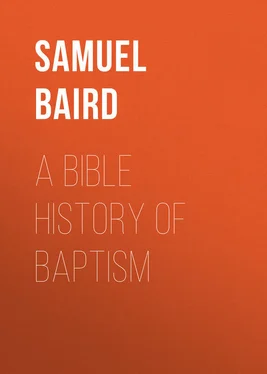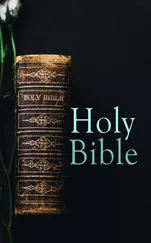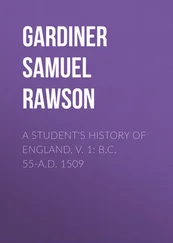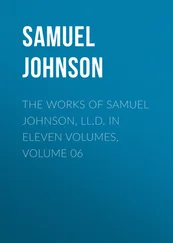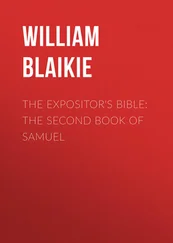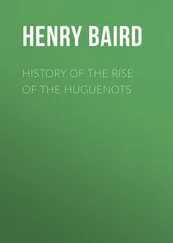Samuel Baird - A Bible History of Baptism
Здесь есть возможность читать онлайн «Samuel Baird - A Bible History of Baptism» — ознакомительный отрывок электронной книги совершенно бесплатно, а после прочтения отрывка купить полную версию. В некоторых случаях можно слушать аудио, скачать через торрент в формате fb2 и присутствует краткое содержание. Жанр: foreign_antique, foreign_prose, на английском языке. Описание произведения, (предисловие) а так же отзывы посетителей доступны на портале библиотеки ЛибКат.
- Название:A Bible History of Baptism
- Автор:
- Жанр:
- Год:неизвестен
- ISBN:нет данных
- Рейтинг книги:5 / 5. Голосов: 1
-
Избранное:Добавить в избранное
- Отзывы:
-
Ваша оценка:
- 100
- 1
- 2
- 3
- 4
- 5
A Bible History of Baptism: краткое содержание, описание и аннотация
Предлагаем к чтению аннотацию, описание, краткое содержание или предисловие (зависит от того, что написал сам автор книги «A Bible History of Baptism»). Если вы не нашли необходимую информацию о книге — напишите в комментариях, мы постараемся отыскать её.
A Bible History of Baptism — читать онлайн ознакомительный отрывок
Ниже представлен текст книги, разбитый по страницам. Система сохранения места последней прочитанной страницы, позволяет с удобством читать онлайн бесплатно книгу «A Bible History of Baptism», без необходимости каждый раз заново искать на чём Вы остановились. Поставьте закладку, и сможете в любой момент перейти на страницу, на которой закончили чтение.
Интервал:
Закладка:
Illustrations from the Scriptures might be multiplied, showing this origin of the form of baptism. Isaiah says of the blessings to be bestowed on Israel in the latter days, that the times of desolation shall continue “until the Spirit be poured upon us from on high, and the wilderness be a fruitful field, and the fruitful field be counted for a forest.” – Isa. xxxii, 15. In another place he cries, “Drop down, ye heavens from above, and let the skies pour down righteousness; let the earth open, and let them bring forth salvation, and let righteousness spring up together; I the Lord have created it.” – Isa. xlv, 8. Hosea says of him: “His going forth is prepared as the morning; and he shall come unto us as the rain, as the latter and former rain unto the earth.” – Hosea vi, 3. And again, “Sow to yourselves in righteousness, reap in mercy; break up your fallow ground; for it is time to seek the Lord, till he come and rain righteousness upon you.” – Ib. x, 12.
The whole conception thus unfolded is assailed and repudiated by writers who assume that physical phenomena can not be used to set forth spiritual realities. Dr. Carson insists that “Baptism can not be either pouring or dipping, for the sake of representing the manner of the conveyance of the Holy Spirit, for there is no such likeness. Pouring of the Spirit is a phrase which is itself a figure, and not a reality to be represented by a figure.” 12 12 Carson on Baptism, p. 167.
The learned doctor has confounded himself with his own subtlety. On the day of Pentecost, there was a blessed “reality” of some kind experienced by the apostles and converts. There is no absurdity, such as he imagines, in the supposition that the pouring or sprinkling of water may be an appropriate physical representation and symbol of that spiritual reality, and that words descriptive of that symbol may be appropriate for the verbal designation of the thing signified. If the assertion of Dr. Carson is to be accepted, it is fatal not to baptism only but to the other sacrament also. “Except ye eat the flesh of the Son of man and drink his blood, ye have no life in you.” – John vi, 53. Shall we be told that this language of our Savior “is itself a figure, and not a reality to be represented by a figure.” Then, we may not eat the bread and drink the wine, to represent this very thing, the feeding of the soul, by faith, on Christ. To do so is absurd if Dr. Carson’s position is sound. It is true that a figure of speech of a figure of speech, would be nonsense. But it is equally true that it is the beauty of a metaphor, – the figure in question, – to be susceptible of physical representation. Nor is there any absurdity in the supposition that a spiritual act may be represented by two co-ordinate figures, – the one a figure of physical action, and the other a figure of speech, descriptive of that action.
Besides, the assertion that “baptism can not be either by pouring or dipping for the sake of representing the manner of the conveyance of the Holy Spirit; for there is no such likeness,” is not merely an assumption of knowledge concerning the invisible things of God which no mortal can possess. But, if the language is to be understood in any sense pertinent to the purpose of Dr. Carson, it is a plain contradiction of the testimony of God himself on the subject. True, there is no physical outpouring predicable of God the Spirit. It is as true of the Doctor’s own word; – there is no physical “conveyance of the Holy Spirit.” Does it, therefore, follow that there is no conveyance, no outpouring? He might with as good reason quibble as to the exaltation of Christ, because height and depth are mere relative terms, which change their direction, at every moment of the earth’s motion on its axis and its orbit. His objection equally applies to the entire ritual of the Scriptures, robs it of all spiritual meaning and renders the whole utterly inane and worthless. And yet, if Paul’s testimony be true, the tabernacle and all the vessels of ministry were “patterns of things in the heavens.” – Heb. ix, 23. Are those heavenly things not spiritual? Jesus himself was “the Lamb of God,” the forerunner, John, being witness. Is there any incongruity between this language, and the fact that the sacrificial lambs of the ritual law meant the same thing? If Dr. Carson is right, all this is absurd. Or, is there no spiritual truth involved in these figures? Either the physical analogies to which the Word of God constantly appeals, in figures of speech and similitudes, and upon which the whole ritual system is built, do so correspond with the spiritual realities as to assist us to true conceptions of them, however inadequate, – either the Scriptural figures, forms, and rites were selected because best adapted to convey and illustrate the spiritual ideas designed, or we are mocked by a semblance of revelation which reveals nothing. The assertion cuts us off from all knowledge of the spiritual world. Nay, it leaves us ignorant of the very existence of angel or spirit. For, what is spirit, but the spiritus or breath of man, the air or wind? How, then, upon the theory in question, can the word acquire or convey any idea of immaterial things? Until the portentous position of Dr. Carson shall have been established by something more conclusive than mere assertion, the contrary will stand as the truth of God. Moreover, the assertion, even if admitted, does not affect in the slightest degree, the argument against which it is directed. The fact still remains, conspicuous and unanswerable, – that, whatever be the reason, sprinkling and pouring are, in the Scriptures, constantly used, both in ritual forms, and in figures of speech, to signify the bestowal of the Holy Spirit, by the Mediator, from his throne on high.
Section XXII. — This Ordinance meant, Life to the Dead
The manner of these rites, and the style of the Scriptures in connection with them are based upon the fundamental fact of man’s spiritual condition as by nature dead, by reason of the apostasy and the curse, – “dead in trespasses and sins” (Eph. ii, 1, 5); “being alienated from the life of God” (Ib. iv, 18), so that they are incapable of exercising any of the activities of true spiritual life unto God, and are, therefore, outcast as were the leper and the unclean, from the camp and society of the clean; being “aliens from the commonwealth of Israel, and strangers from the covenants of promise.” – Ib. ii, 12. In short, the death which by sin, through one man, entered the world was the death of the soul. With reference to it, Jesus says, – “I am the resurrection and the life: he that believeth in me though he were dead, yet shall he live: and whosoever liveth and believeth in me shall never die.” – John xi, 25, 26. But inasmuch as a dead soul can not sustain life in the body, the latter too died with the soul, in the day of its death. For a little time, through the mercy of God, in order to salvation (2 Peter iii, 15), an expiring struggle is maintained; but it is with bodies ever stooping to the grave and irresistibly drawn downward into its yawning gulf. It is in view of these facts that Paul describes the old man, the carnal or inherited nature, as “the body of this death,” or “this dead body;” and its works as “dead works” (Heb. vi, 1; ix, 14) which he represents to be “all manner of concupiscence,” or evil desires, and consequent evil deeds. (Rom. vii, 8-24.) Hence, the seven days’ uncleanness, signifying the deadness of the soul, and the offensiveness of its works. Coincident in meaning was the defilement of things by the contagion of death. For man’s sake, the ground itself is cursed (Gen. iii, 17), and every product of the earth and every possession of man upon it is involved in the curse, and until delivered from it, is unsanctified to man’s use. Hence, the house, the bed, the furniture and utensils, were defiled by the presence of the dead and unfitted for the use of the clean, the living.
Читать дальшеИнтервал:
Закладка:
Похожие книги на «A Bible History of Baptism»
Представляем Вашему вниманию похожие книги на «A Bible History of Baptism» списком для выбора. Мы отобрали схожую по названию и смыслу литературу в надежде предоставить читателям больше вариантов отыскать новые, интересные, ещё непрочитанные произведения.
Обсуждение, отзывы о книге «A Bible History of Baptism» и просто собственные мнения читателей. Оставьте ваши комментарии, напишите, что Вы думаете о произведении, его смысле или главных героях. Укажите что конкретно понравилось, а что нет, и почему Вы так считаете.
